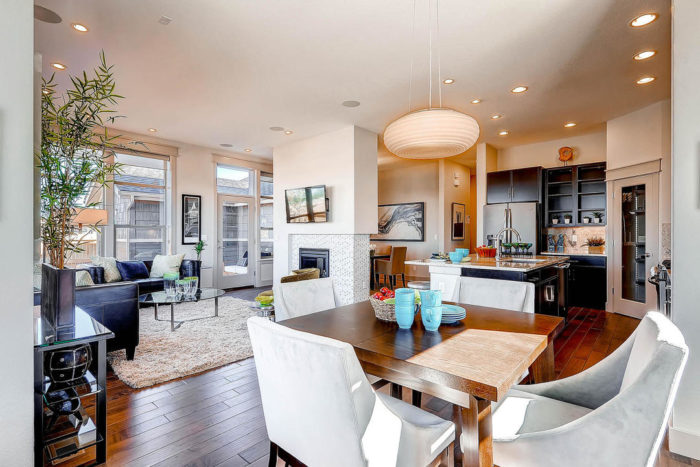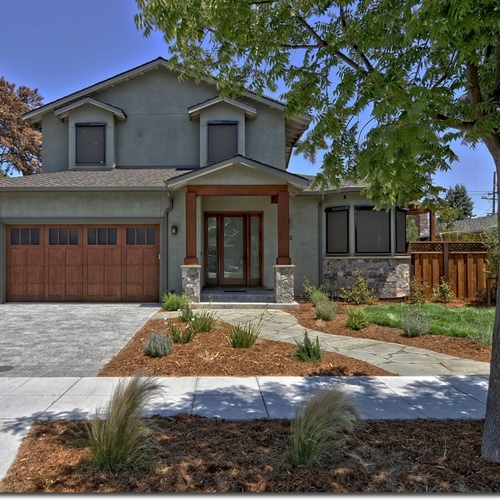Image Credit: New Town Builders
Image Credit: New Town Builders Using common building materials and familiar techniques, New Town Builders is producing a line of net-zero and net-zero ready homes in Denver's Stapleton development. Prices are competitive.
Image Credit: New Town Builders
A production builder working in Denver’s sprawling Stapleton development is buying into the U.S. Department of Energy’s Challenge Home standard in a big way.
New Town Builders, which has sold more than 500 homes in Stapleton since it opened in 2001, has pledged to build each of the 250 to 300 homes it will construct there in the next decade to the high-performance, net-zero-ready standard.
The 7 1/2-square-mile development on what was once the Stapleton International Airport eventually will include 4,600 homes, according to the U.S.Department of Energy. Energy Star is a minimum requirement for houses built there. But last year New Town adopted the more rigorous Challenge Home standard, and this year was declared the winner of the department’s Housing Innovation Awards in the production building category. It was one of a number of Challenge Home awards announced at the Solar Decathlon in October in Irvine, Calif.
Challenge Home houses must meet a number of efficiency and quality requirements verified by third-party inspections. Houses built to this standard are 40% to 50% more efficient than a typical new house and have a Home Energy Rating System (HERS) index in the low to mid 50s, the Energy Department says.
Simple techniques, standard materials
New Town worked with several consultants on the design of the home, using both the HERS software and the Passive House Planning Package. Like other high-performance homes, those built by New Town have tight building envelopes and more insulation than conventional houses. But neither building materials nor building techniques are especially exotic.
“I think the remarkable thing about our envelope is that it is simple,” New Town operations vice president Bill Rectanus said in a news release from the DOE. “It is built with standard construction materials that are used onsite every day. We are not having to retrain our subcontractors to use some new, high-tech product.”
Double-stud exterior walls, consisting of two 2×4 walls separated by a 2 1/2-in. space, are filled with blown-in fiberglass insulation rated at R-36. Studs, 24 in. on center, are staggered to minimize thermal bridging, and walls are built using advanced framing techniques to reduce thermal bridging and save wood.
“This wall works well for our climate zone,” Rectanus said. “And every framer in town knows how to frame a 2×4 wall, so it helped us reach a competitive price point.”
Vented roofs are built with raised-heel trusses with 14 in. of height at the wall plate and insulated with blown-in fiberglass to R-50. Concrete foundation walls, a standard 8 in. thick, are insulated on the interior to R-19. Airtightness on the three-bedroom, 3,560-sq. ft. house cited by the Energy Department was measured at 2.11 air changes per hour at at pressure difference of 50 pascals.
Windows are double-glazed, low-e units with a U-value of 0.28 and a solar heat gain coefficient of 0.22.
Net-zero energy design
New Town offers houses built to two different specs at Stapleton. The Solaris II comes with a 2.75-kW photovoltaic (PV) array and HERS ratings from the high 30s into the low 40s, the Energy Department said. A zero-energy option on this series (the type of house that won the Building Challenge award) includes a 9.5-kW PV system that brings the HERS rating to zero.
New Town’s Z.E.N. (“zero energy now”) series homes have HERS ratings of 40 without a PV system and can become zero-energy with the addition of a PV array with a capacity of between 7 kW and 8 kW.
Other features include:
- Whole-house ventilation provided by a continuously operating fan in a first-floor hallway.
- A tankless water heater for domestic hot water with a PEX plumbing distribution system and on-demand hot-water recirculation.
- A forced-air heating and cooling system that includes a 97.4% AFUE furnace and a 16 SEER air conditioning unit.
- Low-flow shower heads and drip irrigation.
Z.E.N. homes are available with 3 to 5 bedrooms and 2 1/2 or 3 1/2 bathrooms; the homes sell from the low to mid $400,000s. “We are absolutely competitive and priced right there with the other builders in Stapleton,” New Town Builders marketing director Susan Elovitz says.
Weekly Newsletter
Get building science and energy efficiency advice, plus special offers, in your inbox.
















0 Comments
Log in or create an account to post a comment.
Sign up Log in